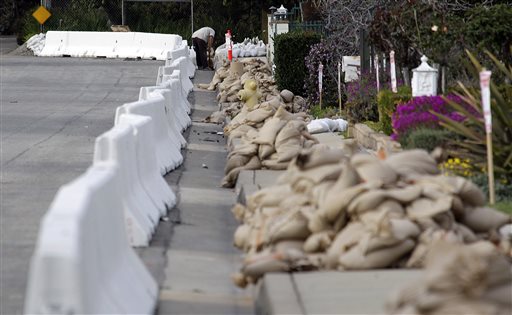LOS ANGELES (AP) — The first wave of a powerful Pacific storm spread rain and snow early Friday through much of California, where communities endangered by a wildfire just weeks ago now faced the threat of mud and debris flows.
The barren mountain slopes looming above neighborhoods in the foothill cities of Glendora and Azusa east of Los Angeles were still holding after the first bout of rain, said police Lt. Matt Williams. Mandatory evacuation orders were issued for about 1,000 homes in the area on Thursday.
“We are cautiously optimistic,” Williams said.
Numerous traffic accidents occurred on slick or flooded roads across Southern California, and a 10-mile stretch of Pacific Coast Highway west of Malibu was closed as a precaution against possible rockslides from a fire-scarred section of the Santa Monica Mountains.
Rain was also falling in the central coast counties, in the San Francisco Bay region and in the Central Valley. Winter storm warnings were in effect in the Sierra Nevada for heavy snowfall.
Forecasts called for the storm to last through Saturday in California, bringing some relief amid a long-running drought, and to spread east into similarly parched neighboring states. Phoenix was expecting its first noticeable precipitation in two months.
Around San Francisco Bay, the storm led to an urban and small stream flood warning, as rain in excess of a half-inch an hour moved in, according to the National Weather Service. Wet roadways and crashes slowed the morning commute, and there were isolated power outages.
In San Jose, a driver had to abandon his vehicle after attempting to drive through a flooded street and becoming stranded, police said. The driver was not hurt.
Some arriving flights at San Francisco International Airport were delayed by more than four hours, according to the Federal Aviation Administration.
The storm’s full force was expected to be felt later Friday morning, with possible thunderstorms and rains up to an inch per hour, the National Weather Service said.
On Thursday, mandatory evacuation orders were issued for about 1,000 homes in Glendora and Azusa, about 25 miles east of Los Angeles that sit beneath nearly 2,000 acres of steep mountain slopes stripped by fire in January. People were not forced out, but some residents quickly heeded the call.
“We have an hour to get evacuated,” said Dana Waldusky as she hurried to evacuate the family home next to the burn area in Glendora. “We’re just boarding up all our doors.”
Waldusky, 22, said she, her parents and sister made sure they had important documents, photos, medicines and their toothbrushes packed.
The home survived the fire, which firefighters stopped 15 feet from their back fence.
“This time there’s nothing you can do. You can’t stop water,” she said.
While concern was highest in the Glendora-Azusa area, meteorologists also posted flood watches for many other areas denuded by fires over the past two years.
Cities in Santa Barbara and San Luis Obispo counties were handing out sandbags in anticipation of heavy rain.
Even waterspouts offshore and small tornados were possible, the weather service said.
Strong winds and snow down to elevations of 7,000 feet were expected in the mountains of San Bernardino and Riverside counties Friday, and at lower elevations on Saturday.
California’s rain totals are far below normal and it will take a series of drenching storms to make a dent in a statewide drought that is among the worst in recent history.
The state Department of Water Resources took a new survey of the Sierra Nevada snowpack on Thursday and found the water content at only 24 percent of average for the date. The northern and central Sierra snowpack normally provides about a third of the water used by California’s cities and farms.

COMMENTS
Please let us know if you're having issues with commenting.